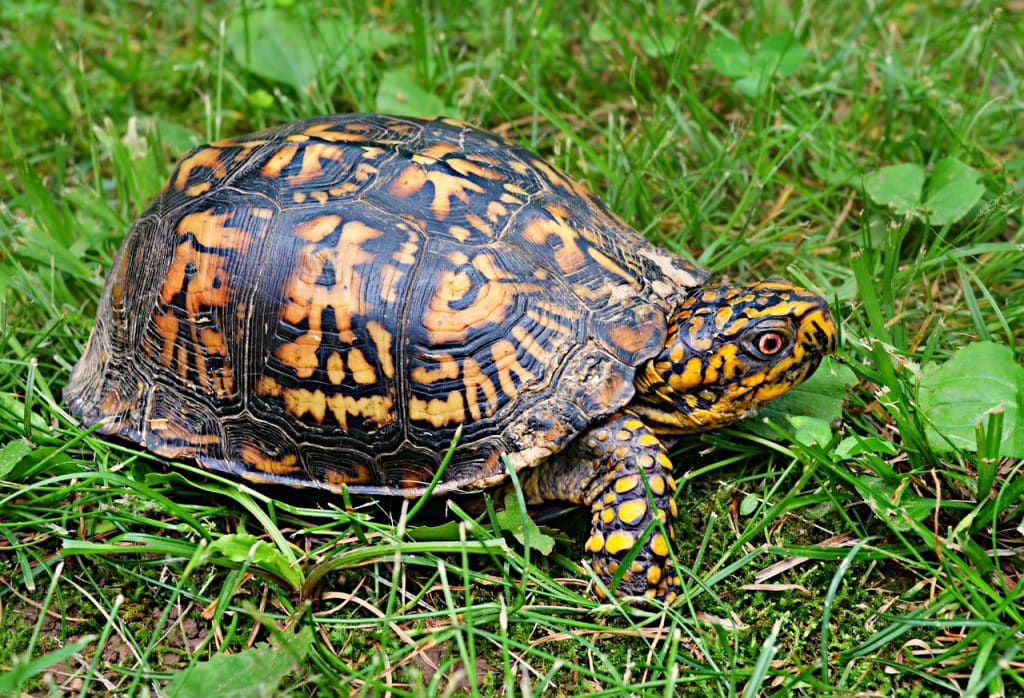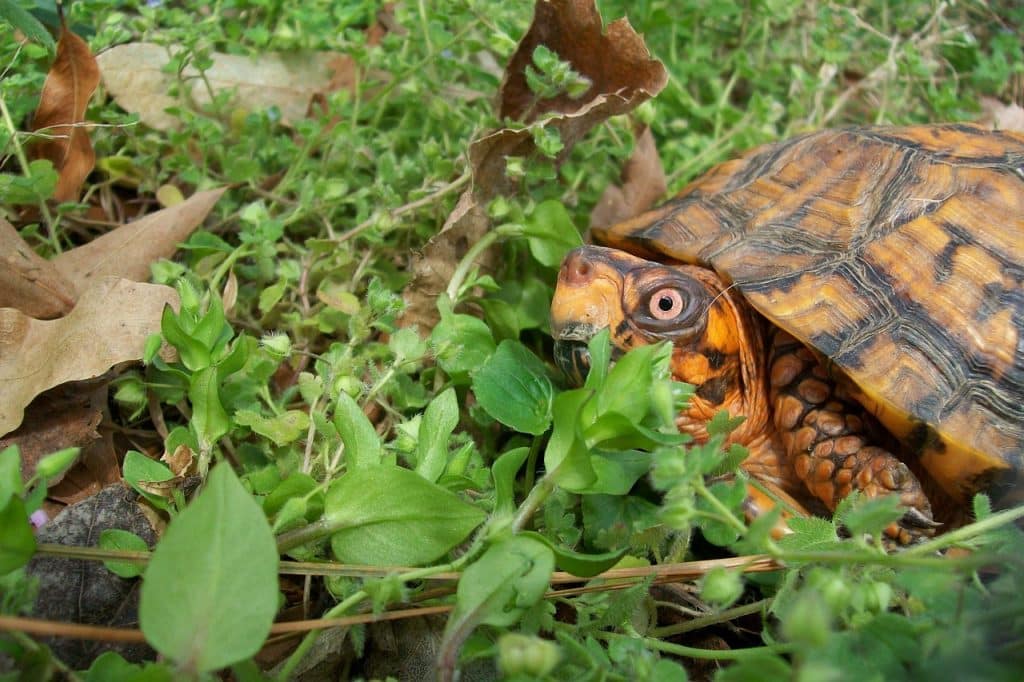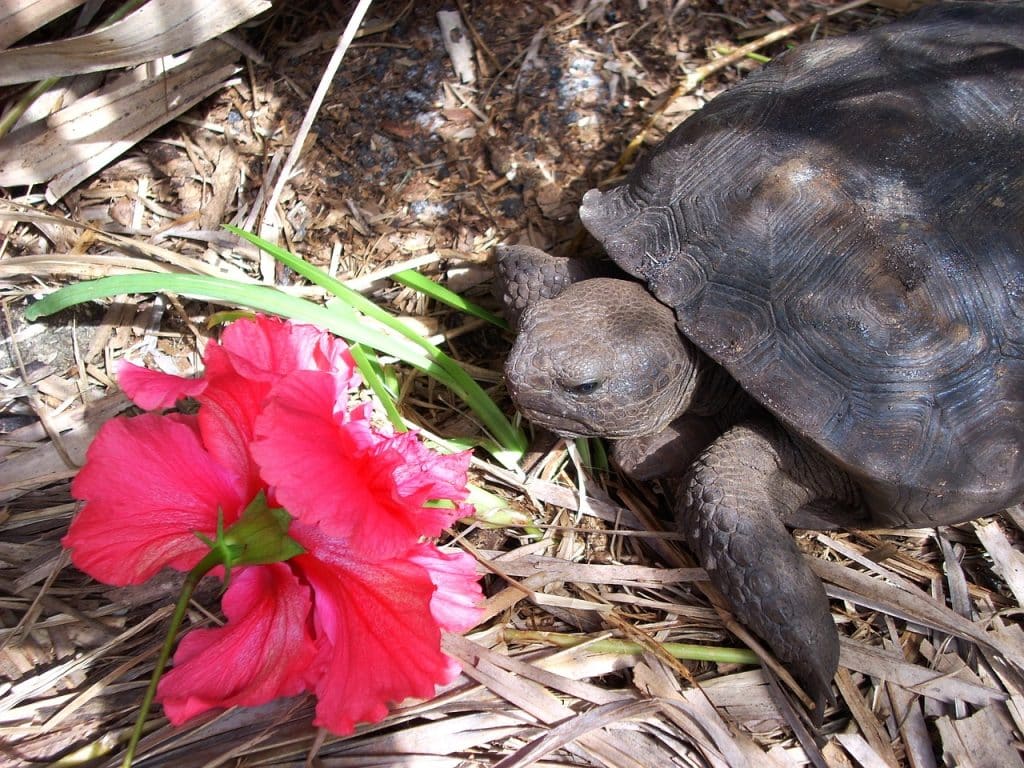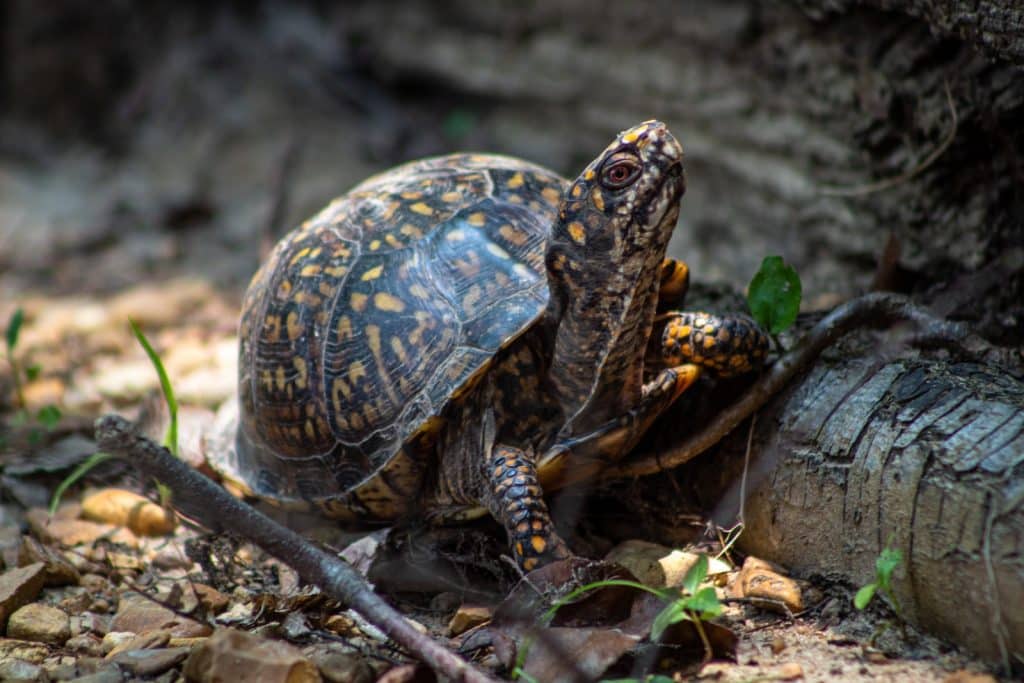
Box Turtles are tough reptiles that can live for many years in captivity and the wild. When properly cared for, these turtles can live up to 30-60 years. A healthy diet is key to their longevity.
Box Turtles belong to the genus Terrapene. The most popular species of Box Turtles that are kept as pets are the Eastern Box Turtle and Gulf Coast Box Turtle. All Box Turtles can eat both animal and plant-based food in captivity or in the wild. These foods will vary depending on the Box Turtle’s age and species, as some Box Turtles are more carnivorous than others.
This article will discuss the best diet for Box Turtles kept in captivity and their natural diet in the wild.
Facts about Box Turtles
| Size: | 2-6 Inches |
| Weight: | 1.5 pounds |
| Lifespan: | 30-60 Years |
| Species: | Ornata |
| Genus: | Terrapene |
| Class: | Reptilia |
What do Box Turtles eat in the wild?

Box Turtles are omnivores and can be found in wooded areas. There are six species of Box Turtles and several subspecies. Their diet will vary depending on where they live. They will eat a variety of fruits, vegetables, leafy greens, and insects.
Box Turtle hatchlings and young Box Turtles tend to be more carnivorous than their adult counterparts. As they age, they will become more omnivorous. Box Turtles eat a variety of the following in the wild:
- Mushrooms
- Grass
- Flowers
- Berries
- Fruit
- Leaves
- Earthworms
- Snails
- Slugs
- Grasshoppers
- Spiders
- Eggs
- Frogs
- Crustaceans
What does a Box Turtle eat in captivity and what do they eat?
A varied diet is key to ensuring a healthy diet for your pet Box Turtle. You can purchase commercial Box Turtle food online or in pet shops. However, fresh food is vital to ensure your pet gets the right nutrition.
It is a good idea to limit the amount of food you give your Box Turtle to one meal per day and to keep them satisfied with small snacks. This will depend on your Box Turtle’s age and the time of year.

Box Turtles can eat a variety of food, with a 50/50 mix of animal-based and plant-based foods. These fruits and vegetables are great for Box Turtles.
- Carrots (
- Squash (or squash)
- Grapes
- Mushrooms
- Strawberries
- Cantaloupe
- Dark leafy greens
- Green beans
- Apples
- Papaya
As we mentioned, Box Turtles are omnivores. They need insects and other animal food. These items can be purchased at most pet shops or found in your garden.
- Slugs
- Snails
- Mealworms
- Earthworms
- Caterpillars
- Beetles
- Grasshoppers
- Crickets
- Eggs
- Pinky mice

Adult vs baby Box Turtle diet
Hatchling Box Turtles require a special diet for their first year. They need more protein than adults and have different dietary needs. Although some owners suggest giving their babies a strictly carnivorous diet it is best to give them small amounts of fruits and vegetables. These foods may be ignored by them, which is not a problem. However, experts are still trying to understand the Box Turtle diet.
During the first four years of their lives, Box Turtles develop very quickly. After that point, they reach sexual maturity. Their growth rate then slows down significantly. They may continue to grow for 10-15 more years, but they will only reach their full size in about 20. Their growth slows at 5 years of age and they will need fewer calories. It is possible to give them small snacks and not feed them a large meal. This is a common practice in reptile husbandry. It is also beneficial to allow your Turtle to fast for a few days every two weeks.
A Box Turtle’s adult diet should contain 50% protein from insects or animals, 40% fruits and veggies, and 10% leafy vegetables.
Avoid feeding your Box Turtle with certain foods

Box Turtles are likely to eat and drink almost everything in the wild. Their diet is so varied that it’s difficult to avoid giving them food. Some foods should be avoided.
- Commercial cat and dog food
- Diary
- Meat processed
- Sugar
- Wheat (bread, pasta).
- Potato leaves
- Tomato leaves
- Avocado skin and pits
Last Thoughts
In the wild, Box Turtles eat a wide variety of foods. They eat almost everything they find and will eat anything that is offered to them. In captivity, they should be fed the same variety of fruits and vegetables as their wild diet. Although commercial food is excellent, it should be replaced with fresh greens, fruits, and vegetables as well as animal proteins.
The diet of a Box Turtle in captivity should be as close as possible to the wild diet.
What do box turtles prefer to eat?
The majority of the plant material supplied to box turtles (80-90%) should be vegetables and flowers, with barely 10-20% fruit. Dark, leafy greens should be the majority of the diet. Vegetables in yellow, red, and orange can also be added.
What makes box turtles content?
Your turtle should flourish if they have a sufficient tank, clean water, suitable temperatures, plants and decorations, a basking location, and balanced food. Providing him with toys and live food to keep him cognitively busy can also result in a very happy turtle.
Do box turtles care about me?
Tortoises may exhibit affection by touching their snout to your hand or arm. This is a social behavior that is prevalent in the wild. A tortoise or turtle following you around the house or yard may indicate affection. They may bump into you for some pats or simply follow you a few meters.
How smart are box turtles?
In tests, wood turtles outperformed white rats in finding their way through mazes. The Florida Red-bellied Cooter was shown to have a memory that lasted at least seven and a half months in laboratory experiments.
What do box turtles do throughout the night?
Eastern box turtles are active during the day. During the day, box turtles scavenge for food, look for partners, and explore their area. It spends the night in shallow forms that are carved out at nightfall.
What do you feed a box turtle captured in the wild?
They are omnivores and require a diet rich in protein (meat), fruits, and vegetables. Eastern box turtles’ meals in the wild can comprise a diverse range of food sources, including flowers, roots, mushrooms, berries, snails, slugs, insects, fish, and frogs.
Do wild box turtles transmit disease?
Turtles frequently carry germs that may make people severely ill on their exterior skin and shell surfaces. People can also be infected by geckos and bearded dragons. Salmonella bacteria are typically found on the exterior skin and shell surfaces of turtles.
What are the requirements for an outdoor box turtle habitat?
An Eastern box turtle habitat in an outdoor classroom is an enclosed environment with a small pond that provides water, plants that give shelter, and a sandy area where they may lay their eggs.
Where should a box turtle be released into the wild?
After determining that the turtle is not wounded, determine whether it is a native box turtle. If it’s a natural species in your region, by all means, return it to where it was discovered. If it crosses a road, place it in the nearest woods in the direction it was going.
Do box turtles make nice pets?
Box turtles are excellent pets if properly cared for. Before introducing any pet – reptile or otherwise – into your house, do some study to learn about its needs so that you may properly care for it. The majority of box turtles do not grow to be extremely huge (unlike tortoises)